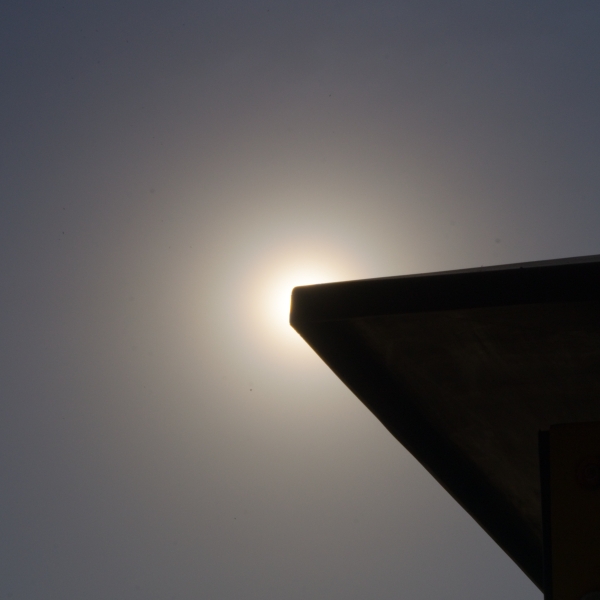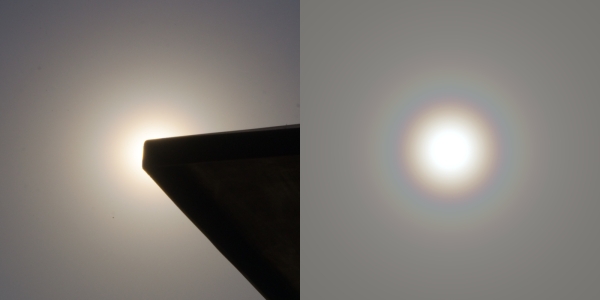Category Archives: pollen and algae phenomena
Olea europaea pollen corona
During the days of the 12th Light & Color in nature meeting (May 31st-June 3rd, 2016) in Granada, Spain, I noticed almost constantly a diffuse aureole around the sun, appearing against the background of a clear sky:

previous picture unsharp masked
All photos were cropped to a common viewing angle of 15° x 15° and the color saturation was increased.
Because of the dry and often cloudless summer weather we had back then, it seems unlikely that any kind of water drops did cause the phenomenon. On the other hand, the angular radius was way too small for Bishop’s ring, which at first seemed to be a plausible option as we had observed some haze towards Africa shortly before our plane landed in Malaga on May 30th.
No pronounced color pattern was visible to the naked eye, nor through a gray filter, but the saturation increase in the image processing revealed a typical corona structure with alternating colors. Thinking of pollen as possible scattering particles, the large amount of olive trees (olea europaea) in Andalusia immediately comes to mind. Furthermore, we witnessed ourselves that the olive trees were blooming these days when we visited a grove at Monachil in the vicinity of Granada – some of the visitors’ shirts or backpacks got covered with green dust after coming too close to the trees.

The olive grove at Monachil with the Sierra Nevada in the background (June 2nd, 2016)

A blooming olive twig from a tree in this grove (June 2nd, 2016, photographed by Hironobu Iwabuchi)
In order to check this hypothesis I looked up the shape and size of olive pollen: They are almost spherical with a mean polar diameter of 20.1 µm and mean equatorial diameter of 21.5 µm. For most of the observations, the sun elevation was high enough to simply approximate the pollen as spheres of 21.5 µm in size. I calculated the resulting corona from the solar spectrum using simple diffraction theory (which at this particle sizes is justified):
Both the photograph and the simulation (right hand side) were cropped to a field of view of 10° x 10°. For the simulation, I assumed a relative spread in the pollen size (standard deviation of a Gaussian distribution divided by the mean diameter) of 15%, convoluted the result with the sun’s disk and added a gray background. It matches the photograph quite well, though the contrast of the natural corona remains lower than that of the simulation. Maybe there were other scattering particles with a broader size distribution present, which added another, rather colorless aureole “layer” on top of the pollen corona, thereby diminishing its contrast. Surprisingly, I could not find any previous reports about “olive pollen coronae”, though the phenomenon should be quite prominent during the right season in the olive-growing regions.
Reflected Sunlight Dewbow
On August 19, 2010, Jérémie Gaillard made an interesting discovery when looking at the surface of the lake Etang de l´Alleu which is located in the French community of Saint-Arnoult-en-Yvelines. The water was covered with pollen, on which droplets of dew had formed. In these droplets two colourful rainbows were visible. Dewbows can be understood as the lower part of a rainbow projected onto a horizontal plane. When a dewbow is fully developed, a semi-circle which opens towards the sides should be visible, the apex of which is situated at the lower end of the observer´s shadow. Equivalent to normal rainbows, primary and secondary dewbow should run parallely, but in Jérémie Gaillard´s observation they did not.
Instead, the second colourful bow fragment is a reflected sunlight dewbow. The surface of the water acts as a large mirror reflecting the sun. The reflected image of the sun now acts as a second source of light, which is situated as far below the horizon as the sun is above it. (angle of incidence = emergent angle). So the antisolar point for the reflection of the sun is above the horizon. This reflected antisolar point, which is located the double of the real sun´s elevation above the antisolar point, is the centre of the two rainbow circles for the reflected sunlight. So the additional rainbows are displaced upwards by the double sun elevation compared to the primary and secondary rainbow, making a rather unfamiliar appearance in the open nature.
Author: Claudia Hinz
Algae optics in Wisconsin
While on my 4-wheeler riding around in the wood in Lakewood Wisconsin I came upon a puddle with a green film in it in the middle of a dirt road and I drove up to check it out and I am glad I did! As I was dismounting from my 4-wheeler colors on the puddle caught my attention and I found the same thing Marko Riikonen found algal optics. Over the period of 10 minutes or more I observed corona similar to pollen corona around sun’s reflection and Quetelet rings which I have always wanted to see. I also saw glory with the similar brightening’s like pollen corona and a white fogbow like glow around the glory. More pictures here.
Author: Michael Ellestad, Wisconsin, USA
Algae corona
This photograph was taken by Hans-Jürgen Heyen from Meerbusch. “I discovered the glory effect in August 2012 at the pond of Hugenpoet Castle in Essen-Kettwig. It made me take a closer look at the water because one tends to think that there are mineral oil products on the surface. But there were gigantic carps in the pond and also some big golden fish which looked like koi-carps. And also a beautiful demoiselle flew over the water. And especially this species of dragonflies is very sensitive against environmental pollution. However, what really was there in the water were algae which caused a significant clouding of the water, and this obviously was the reason for the formation of the algae glory.”
These coronae are caused by light diffraction on very small particles. In most cases, they are caused by algae, but there were also such coloured rings observed around pollen which had landed on the water surface. The coronae are caused when a ray of light is split up into partial beams by such a small particle. These partial beams go on into different directions and interfere in the observer´s eye.
Just like pollen coronae, also algae coronae are not always round. When there are unusually shaped algae are involved, also their ring systems on the water surface can be ovally shaped or have bright spots.
Reflected light dewbow on water surface
I and my wife Eliisa Piikki got a hint about a light phenomenon on a lake nearby. Eliisa took some photos and there was a dewbow and a reflected light dewbow in those photos. They were formed on the waterdroplets that were settled down on the Chrysomyxa ledi needle rust (Small-spored spruce-Labrador-tea rust).
That rust can’t be seen in Finland every year, but this year it is very common especially in the Eastern and in the Northern Finland. Because of the rust the young needles of some spruces are brown.
Author: Jari Piiki, Finland
Pollen corona in Deventer, The Netherlands
On April 1st 2009, Peter Paul Hattinga Verschure observed beautiful pollen coronae from his garden in Deventer, The Netherlands. Every time the wind blew through the pine trees, a cloud of pollen was blown away from them. When these clouds of pollen passed exactly in front of the sun, a beautiful pollen corona appeared. So, in one second it was bright and had three rings, in the next moment it disappeared again.
Colourful bacteria film
On September 14, 2007, Reinhard Nitze saw intensely iridescent colours in some puddles on a lane near Barsinghausen/Egestorf (Lower Saxony, Germany). These were probably caused by bacteria of putrefaction coming from decomposing grains of wheat in the water, just as the colours showed up only in those puddles containing larger amounts of grains. The grains originated from the fields along the lane and had probably fallen from a trailer when the harvest was brought in.As some of the grains were already covered with green algae, they must have been lying in the water for some time already. Also remarkable was the rusty colour of those puddles which had already fallen dry.
Thin film interference on the water surface
In the city of Lahti there is a landfill hill from which base in some places flows iron rich water. The bottom of these ditches is rusty brown and water has a strong iron smell. In some locations the water surface is completely covered with a film that displays spectacular colors in cloudy weather. This film is caused by iron oxidizing bacteria. The bacteria itself resides in the water, but it produces on the water surface substances from which it hangs down like a chain of sausages. Iron oxide is one of these products and it may be the cause of colors.
Author: Marko Riikonen
Algal optics
The season for algal optics has started, the first display was seen here in Finland already in the beginning of April.
The algal films that display optical phenomena are clearly not as rare as have been thought. In the Baltic sea rocky islands about every 10th freshwater pool came with algal optics last summer. In Bulgaria, the species Chromophyton rosanoffii, which is responsible for the phenomena in the photo, has been described as common.
When it has not been raining for some days, go look for any freshwater ponds, puddles and pools. If the water surface is covered by a thin film, chances are that some sort of optical phenomena is visible in the sun light.
Author: Marko Riikonen
Small coronas from bacterial film on water surface
Most of the cultivation pools in my room are now showing much smaller coronas than earlier. In each pool the corona is of constant size over the whole bacterial film surface, but from pool to pool their size vary.
Even though these coronas are smaller than before, they still are large as compared to pollen coronas. Unfortunately I have no photos for comparison.
In the composite image are two coronas photographed with same lens (not to scale with upper single image, which has been taken with zoom lens). The microphotograph of the bacterial film is from the smaller corona on the left.
The light source was a 50 W halogen spotlight that I made even more concentrated by placing the lamp in a cardboard box, into which a small hole was made for light to come through. When taking photos, the room was otherwise darkened.
[Posted by Marko Riikonen]



















